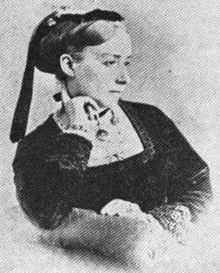Mary Sumner

Mary Sumner (31 December 1828 – 11 August 1921[1]) was the founder of the Mothers' Union, a worldwide Anglican women's organisation. She is commemorated in a number of provinces of the Anglican Communion on 9 August (see below).
Mary Sumner was born Mary Elizabeth Heywood in Swinton near Salford, Lancashire, the third of four children. Her father was a banker and keen amateur historian and her mother was a woman of personal piety. The family moved to Colwall near Ledbury, Herefordshire, in 1832, where Sumner's mother held mothers' meetings. A year after their arrival in Herefordshire, Sumner's six-week-old brother died. Her mother's faith, her women's meetings and her brother's infant death may have all inspired her to begin the Mothers' Union. She was educated at home and learnt to speak three foreign languages and to sing well. To complete her musical education, she travelled with her mother and elder sister to Rome. Whilst there she met her future husband, George Henry Sumner, the son of Charles Richard Sumner, the Bishop of Winchester and a relative of William Wilberforce. The couple were married in Colwall on 26 July 1848, 18 months after George's ordination as an Anglican cleric. They had three children: Margaret, Louise and George; the latter became a well known artist.
In 1851, George Sumner was given the living of Old Alresford, Hampshire, in his father's diocese. Sumner dedicated herself to raising her children and helping her husband in his ministry by providing music and Bible classes. In 1876, when her eldest daughter Margaret gave birth, she was reminded how difficult she had found the burden of motherhood. She was inspired to call a meeting of mothers in the parish to offer mutual support. Her plan was quite radical in its day as it involved calling women of all social classes to support one another and to see motherhood as a profession as important as those of men, if not more so. The first meeting was held in Old Alresford Rectory, but Sumner was so overcome by nervousness that her husband had to speak for her and invite the women to return next week. At that second meeting she had gathered enough courage to lead her own meeting.
The nascent Mothers' Union was limited to Sumner's parish. However, in 1885, she was part of the audience in the Portsmouth Church Congress, some 20 miles from her home. The first Bishop of Newcastle, Ernest Wilberforce, had been asked to address the women churchgoers. He felt that he had very little to say to women and invited Sumner to speak in his stead. Although nervous once again, she gave a passionate address about national morality and the importance of women's vocation as mothers to change the nation for the better. A number of the women present went back to their parishes to found mothers' meetings on Sumner's pattern and the then Bishop of Winchester, Edward Browne, made the Mothers' Union a diocesan organisation.
Rapidly, the Mothers' Union spread to the dioceses of Ely, Exeter, Hereford, Lichfield and Newcastle and then throughout the United Kingdom. By 1892, there were 60,000 members in 28 dioceses, which grew to 169,000 members by the turn of the century. In 1893, annual general meetings were organised, and, in 1896, the Mothers' Union Central Council was formed. Sumner was unanimously elected president, a post she held into her nineties. In 1897, during her Diamond Jubilee, Queen Victoria became patron of the Mothers' Union, giving it an unprecedented stamp of approval. The Mothers' Union set up branches throughout the British Empire, beginning in New Zealand, then Canada and India. Sumner lived to lead the Mothers' Union to act in rebuilding the heart of Britain after the First World War and saw the first Mothers' Union Conference of Overseas Workers in 1920.
Sumner died on 11 August 1921 at the age of 92, as shown in the detailed and dated first-hand account of her last days in Horace Porter's Mary Sumner: Her Life and Work (published by the Mothers' Union, pp. 97–98). The formal acceptance of her date of death by the MU is recorded as 9 August as shown in a secondary source 'Exciting Holiness' - collects and readings for festivals). The mistake may be due to a misreading of the vague account in Joyce Coombs' George and Mary Sumner (The Sumner Press, p. 184.). She is buried with her husband, who had died 12 years before, in the grounds of Winchester Cathedral. She is commemorated in the liturgical calendars of the Church of England, the Church in Wales and other provinces on 9 August, because of the mistake referred to, rather than on the actual date of death, 11 August (which would place her commemoration on the same day as another notable Christian woman, St Clare of Assisi).
References
- ↑ Johnston, Pamela. "Sumner (née Heywood), Mary Elizabeth (1828–1921), founder of the Mothers' Union". Dictionary of National Biography. Retrieved 6 September 2011.
|